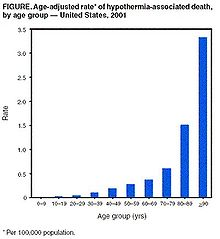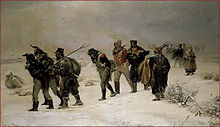- Hypothermia
-
This article is about the adverse condition of Hypothermia. For deliberately induced cooling, see Therapeutic hypothermia. For the 2010 horror film, see Hypothermia (film).
Hypothermia Classification and external resources 
During Napoleon Bonaparte's retreat from Russia in the winter of 1812 many troops suffered from hypothermia.ICD-10 T68 ICD-9 991.6 DiseasesDB 6542 eMedicine med/1144 MeSH D007035 Hypothermia (from Greek υποθερμία) is a condition in which core temperature drops below the required temperature for normal metabolism and body functions which is defined as 35.0 °C (95.0 °F). Body temperature is usually maintained near a constant level of 36.5–37.5 °C (98–100 °F) through biologic homeostasis or thermoregulation. If exposed to cold and the internal mechanisms are unable to replenish the heat that is being lost, a drop in core temperature occurs. As body temperature decreases, characteristic symptoms occur such as shivering and mental confusion.
Hypothermia is the opposite of hyperthermia which is present in heat exhaustion and heat stroke. One of the lowest documented body temperature from which anyone has recovered was 13.0 °C (55.4 °F), in a drowning incident involving a 7-year-old girl in Sweden in December 2010.[1]
Contents
Classification
Temperature Classification Core (rectal, esophageal, etc.) Normal 36.5–37.5 °C (97.7–99.5 °F)[2] Hypothermia <35.0 °C (95.0 °F)[3] Fever >37.5–38.3 °C (99.5–100.9 °F)[4][5] Hyperthermia >37.5–38.3 °C (99.5–100.9 °F)[4][5] Hyperpyrexia >40.0–41.5 °C (104–106.7 °F)[6][7] Note: The difference between fever and hyperthermia is the mechanism. Normal human body temperature in adults is 34.4–37.8 °C (94–100 °F).[8] Sometimes a narrower range is stated, such as 36.5–37.5 °C (98–100 °F).[9] Hypothermia is defined as any body temperature below 35.0 °C (95.0 °F). It is subdivided into four different degrees, mild 32–35 °C (90–95 °F); moderate, 28–32 °C (82–90 °F); severe, 20–28 °C (68–82 °F); and profound at less than 20 °C (68 °F).[10] This is in contrast to hyperthermia and fever which are defined as a temperature of greater than 37.5 °C (99.5 °F)-38.3 °C (100.9 °F).[5]
Other cold-related injuries that can either be present alone or in combination with hypothermia include:
- Chilblains are superficial ulcers of the skin that occur when a predisposed individual is repeatedly exposed to cold.[11]
- Frostbite involves the freezing and destruction of tissue.[11]
- Frostnip is a superficial cooling of tissues without cellular destruction.[12]
- Trench foot or immersion foot is due to repetitive exposure to wet, non-freezing temperatures.[11]
Signs and symptoms
The signs and symptoms vary depending on the degree of hypothermia and may be divided by the three stages of severity.
Mild
Symptoms of mild hypothermia may be vague[13] with sympathetic nervous system excitation (shivering, hypertension, tachycardia, tachypnea, and vasoconstriction). These are all physiological responses to preserve heat.[14] Cold diuresis, mental confusion, as well as hepatic dysfunction may also be present.[15] Hyperglycemia may be present, as glucose consumption by cells and insulin secretion both decrease, and tissue sensitivity to insulin may be blunted.[16] Sympathetic activation also releases glucose from the liver. In many cases, however, especially in alcoholic patients, hypoglycemia appears to be a more common presentation.[16] Hypoglycemia is also found in many hypothermic patients because hypothermia often is a result of hypoglycemia.[17]
Moderate
Low body temperature results in shivering becoming more violent. Muscle mis-coordination becomes apparent.[18][19][20] Movements are slow and labored, accompanied by a stumbling pace and mild confusion, although the victim may appear alert. Surface blood vessels contract further as the body focuses its remaining resources on keeping the vital organs warm. The victim becomes pale. Lips, ears, fingers and toes may become blue.
Severe
Difficulty in speaking, sluggish thinking, and amnesia start to appear; inability to use hands and stumbling is also usually present. Cellular metabolic processes shut down. Below 30 °C (86 °F), the exposed skin becomes blue and puffy, muscle coordination becomes very poor, walking becomes almost impossible, and the victim exhibits incoherent/irrational behavior including terminal burrowing or even a stupor. Pulse and respiration rates decrease significantly, but fast heart rates (ventricular tachycardia, atrial fibrillation) can occur. Major organs fail. Clinical death occurs. Because of decreased cellular activity in stage 3 hypothermia, the body will actually take longer to undergo brain death.
As the temperature decreases further physiological systems falter and heart rate, respiratory rate, and blood pressure all decreases. This results in an expected HR in the 30s with a temperature of 28 °C (82 °F).[15]
Paradoxical undressing
Twenty to fifty percent of hypothermia deaths are associated with paradoxical undressing. This typically occurs during moderate to severe hypothermia, as the person becomes disoriented, confused, and combative. They may begin discarding their clothing, which, in turn, increases the rate of heat loss.[21][22]
Rescuers who are trained in mountain survival techniques are taught to expect this; however, some may assume incorrectly that urban victims of hypothermia have been subjected to a sexual assault.[23]
One explanation for the effect is a cold-induced malfunction of the hypothalamus, the part of the brain that regulates body temperature. Another explanation is that the muscles contracting peripheral blood vessels become exhausted (known as a loss of vasomotor tone) and relax, leading to a sudden surge of blood (and heat) to the extremities, fooling the person into feeling overheated.[23]
Terminal burrowing
In the final stages of hypothermia, the brain stem produces a burrowing-like behavior. Similar to hibernation behavior in animals, individuals with severe hypothermia are often found in small, enclosed spaces, such as under the bed or behind wardrobes.[24]
Causes
Hypothermia usually occurs from exposure to low temperatures, and is frequently complicated by alcohol. Any condition that decreases heat production, increases heat loss, or impairs thermoregulation, however, may contribute.[25] Thus, hypothermia risk factors include: any condition that affects judgment (hypoglycemia), the extremes of age, poor clothing, chronic medical conditions (such as hypothyroidism and sepsis), substance abuse, homelessness, and living in a cold environment.[26][27] Hypothermia also occurs frequently in major trauma. Hypothermia also is observed in severe cases of anorexia nervosa.
Alcohol
Alcohol consumption increases the risk of hypothermia via its action as a vasodilator. It increases blood flow to the body's skin and extremities, making a person feel warm, while increasing heat loss.[28] Between 33 to 73% of cases of hypothermia are complicated by alcohol.[29][30]
Water
Hypothermia continues to be a major limitation to diving in cold water.[18] The limitation of finger dexterity due to pain or numbness decreases general safety and work capacity, which consequently increases the risk of other injuries.[18][20] Due to the use of gas mixtures containing helium at extreme depths, the use of argon inflation for dry suits, or hot water suits become a necessity for diving deep in colder waters.
Other predisposing factors leading to immersion hypothermia include dehydration, inadequate rewarming with repetitive diving, starting a dive while wearing cold, wet dry suit undergarments, sweating with work, inadequate thermal insulation (for example, thin dry suit undergarment), and poor physical conditioning.[18]
Heat is lost more quickly in water[18] than on land. Water temperatures that would be quite reasonable as outdoor air temperatures can lead to hypothermia. A water temperature of 10 °C (50 °F) often leads to death in one hour, and water temperatures hovering at freezing can lead to death in as little as 15 minutes.[31] Water at a temperature of 26 °C (79 °F) will, after prolonged exposure, lead to hypothermia.[32]
Pathophysiology
Heat is primarily generated in muscle tissue, including the heart, and in the liver, while it is lost through the skin (90%) and lungs (10%).[13] Heat production may be increased 2 to 4 fold through muscle contractions ( i.e. exercise and shivering ).[13] Rates of bodily heat loss are determined, as with any object, by convection, conduction, and radiation.[13] The rates of these can be affected by clothing and other environmental conditions.
Many changes to physiology occur as body temperature decreases. These occur in the cardiovascular system leading to the Osborn J wave and other dysrhythmias, decreased CNS electrical activity, cold diuresis, and non-cardiogenic pulmonary edema.[33]
Diagnosis
 Atrial fibrillation and Osborn J waves in a person with hypothermia. Note what could be mistaken for ST elevation.
Atrial fibrillation and Osborn J waves in a person with hypothermia. Note what could be mistaken for ST elevation.
Accurate determination of core temperature often requires a special low temperature thermometer, as most clinical thermometers do not measure accurately below 34.4°C (94°F).[14] A low temperature thermometer can be placed rectally, esophageally, or in the bladder. The classical ECG finding of hypothermia is the Osborn J wave. Also, ventricular fibrillation frequently occurs at <28°C (82.4°F) and asystole at <20°C (68°F).[13] The Osborn J may look very similar to those of an acute ST elevation myocardial infarction.[15] Thrombolysis as a reaction to the presence of Osborn J waves is not indicated, as it would only worsen the underlying coagulopathy caused by hypothermia.
As a hypothermic person's heart rate may be very slow, prolonged palpation could be required before detecting a pulse. In 2005 American Heart Association recommended at least 30 – 45 seconds to verify the absence of a pulse before initiating CPR.[34]
Most physicians are recommended not to declare a patient dead until their body is warmed to a normal body temperature, since extreme hypothermia can suppress heart and brain function.[35]
Prevention
Appropriate clothing helps to prevent hypothermia. Synthetic and wool fabrics are superior to cotton as they provide better insulation when wet and dry. Some synthetic fabrics, such as polypropylene and polyester, are used in clothing designed to wick perspiration away from the body, such as liner socks and moisture-wicking undergarments.
The United States Coast Guard promotes using life vests as a method of protection against hypothermia through the 50/50/50 rule: If someone is in 50 °F (10 °C) water for 50 minutes, he/she has a 50 percent better chance of survival if wearing a life jacket.[citation needed][36] A heat escape lessening position can be used to increase survival in cold water.
Management
Degree Rewarming technique Mild Passive rewarming Moderate Active external rewarming Severe Active internal rewarming[34] Aggressiveness of treatment is matched to the degree of hypothermia. Treatment ranges from noninvasive, passive external warming, to active external rewarming, to active core rewarming.[14] In severe cases resuscitation begins with simultaneous removal from the cold environment and concurrent management of the airway, breathing, and circulation. Rapid rewarming is then commenced. A minimum of patient movement is recommended as aggressive handling may increase risks of a dysrhythmia.[34]
Hypoglycemia is a frequent complication of hypothermia, and therefore needs to be tested for and treated. Intravenous thiamine and glucose is often recommended as many causes of hypothermia are complicated by Wernicke's encephalopathy.[37]
Rewarming
Rewarming can be achieved using a number of different methods including passive external rewarming, active external rewarming, and active internal rewarming.[38] Passive external rewarming involves the use of a person's own heat generating ability through the provision of properly insulated dry clothing and moving to a warm environment.[39] It is recommended for those with mild hypothermia.[39] Active external rewarming involves applying warming devices externally such as warmed forced air (a Bair Hugger is a commonly used device).[39] In austere environments hypothermia can sometimes be treated by placing a hot water bottle in both armpits and groin.[40] It is recommended for moderate hypothermia.[39] Active core rewarming involves the use of intravenous warmed fluids, irrigation of body cavities with warmed fluids (the thorax, peritoneal, stomach, or bladder), use of warm humidified inhaled air, or use of extracorporeal rewarming such as via a heart lung machine.[38] Extracorporeal rewarming is the fastest method for those with severe hypothermia.[39]
Intravenous fluids
As most people are moderately dehydrated due to hypothermia induced cold diuresis, intravenous fluids are often helpful ( 250–500 cc 5% dextrose and normal saline warmed to a temperature of 40–45 C is often recommended ).[14]
Rewarming collapse
Rewarming collapse (or rewarming shock) is a sudden drop in blood pressure in combination with a low cardiac output which may occur during active treatment of a severely hypothermic person.[41][42] There is theoretical concern that external rewarming rather than internal rewarming may increase the risk. However, recent studies have not supported these concerns.[34]
Prognosis
There is considerable evidence that children who suffer near-drowning accidents in water near 0°C (32°F) can be revived over an hour after losing consciousness.[43] The cold water lowers metabolism, allowing the brain to withstand a much longer period of hypoxia. While survival is possible, mortality from severe or profound hypothermia remains high despite optimal treatment. Studies estimate mortality at between 38%[44][45] – 75%.[13] If there are obvious fatal injuries or the chest is too frozen, compression resuscitation is futile.[34]
Epidemiology
In the past hypothermia occurred most frequently in homeless people, but recreational exposure to cold environments is now the main cause of hypothermia. Between 1995 and 2004 in the United States an average of 1560 cold-related emergency department visits occurred per year and in the years 1999 to 2004 an average of 647 people died per year due to hypothermia.[26][46]
History
Hypothermia has played a major role in the success or failure of many military campaigns from Hannibal's loss of nearly half his men in 218 B.C. to the near destruction of Napoleon's armies in Russia in 1812. Loss of life to hypothermia continued through the first and second world wars, especially in the Battle of Stalingrad.[47] Civilian examples of deaths caused by hypothermia are found during the sinkings of the RMS Titanic and RMS Lusitania.[48][49]
In other animals
Many animals other than humans often induce hypothermia during hibernation or torpor.
Water bears (Tardigrade), microscopic multicellular organisms, can survive freezing at low temperatures by replacing most of their internal water with the sugar trehalose, preventing it from crystallization that otherwise damage cell membranes.
References
- ^ Remarkable recovery of 7-year-old girl, Radio Sweden, 17 January 2011
- ^ Karakitsos D, Karabinis A (September 2008). "Hypothermia therapy after traumatic brain injury in children". N. Engl. J. Med. 359 (11): 1179–80. doi:10.1056/NEJMc081418. PMID 18788094.
- ^ Marx, John (2006). Rosen's emergency medicine: concepts and clinical practice. Mosby/Elsevier. p. 2239. ISBN 9780323028455.
- ^ a b Axelrod YK, Diringer MN (May 2008). "Temperature management in acute neurologic disorders". Neurol Clin 26 (2): 585–603, xi. doi:10.1016/j.ncl.2008.02.005. PMID 18514828.
- ^ a b c Laupland KB (July 2009). "Fever in the critically ill medical patient". Crit. Care Med. 37 (7 Suppl): S273–8. doi:10.1097/CCM.0b013e3181aa6117. PMID 19535958.
- ^ Manson's Tropical Diseases: Expert Consult. Saunders Ltd. 2008. pp. 1229. ISBN 1-4160-4470-1.
- ^ Trautner BW, Caviness AC, Gerlacher GR, Demmler G, Macias CG (July 2006). "Prospective evaluation of the risk of serious bacterial infection in children who present to the emergency department with hyperpyrexia (temperature of 106 degrees F or higher)". Pediatrics 118 (1): 34–40. doi:10.1542/peds.2005-2823. PMC 2077849. PMID 16818546. http://www.pubmedcentral.nih.gov/articlerender.fcgi?tool=pmcentrez&artid=2077849.
- ^ Sund-Levander M, Forsberg C, Wahren LK (June 2002). "Normal oral, rectal, tympanic and axillary body temperature in adult men and women: a systematic literature review". Scand J Caring Sci 16 (2): 122–8. doi:10.1046/j.1471-6712.2002.00069.x. PMID 12000664.
- ^ Karakitsos D, Karabinis A (September 2008). "Hypothermia therapy after traumatic brain injury in children". N. Engl. J. Med. 359 (11): 1179–80. doi:10.1056/NEJMc081418. PMID 18788094.
- ^ Marx, John (2006). Rosen's emergency medicine: concepts and clinical practice. Mosby/Elsevier. p. 2239. ISBN 9780323028455.
- ^ a b c "Cold Stress". Center for Disease Control and Prevention. http://www.cdc.gov/niosh/topics/coldstress/.
- ^ Marx 2010 p.1862
- ^ a b c d e f Hanania, NA, Zimmerman, JL. Accidental hypothermia. Critical Care Clinincs 1999; 15:235.
- ^ a b c d McCullough L, Arora S (December 2004). "Diagnosis and treatment of hypothermia". Am Fam Physician 70 (12): 2325–32. PMID 15617296.
- ^ a b c Marx 2010 p.1869
- ^ a b Altus P, Hickman JW (May 1981). "Accidental hypothermia: hypoglycemia or hyperglycemia". West. J. Med. 134 (5): 455–6. PMC 1272797. PMID 7257359. http://www.pubmedcentral.nih.gov/articlerender.fcgi?tool=pmcentrez&artid=1272797.
- ^ eMedicine Specialties > Emergency Medicine > Environmental >Hypothermia Author: Jamie Alison Edelstein, MD. Coauthors: James Li, MD; Mark A Silverberg, MD; Wyatt Decker, MD. Updated: Oct 29, 2009
- ^ a b c d e Sterba, JA (1990). "Field Management of Accidental Hypothermia during Diving". US Naval Experimental Diving Unit Technical Report NEDU-1-90. http://archive.rubicon-foundation.org/4248. Retrieved 2008-06-11.
- ^ Francis, TJR (1998). "Immersion hypothermia". South Pacific Underwater Medicine Society Journal 28 (3). ISSN 0813-1988. OCLC 16986801. http://archive.rubicon-foundation.org/5975. Retrieved 2008-06-11.
- ^ a b Cheung SS, Montie DL, White MD, Behm D (September 2003). "Changes in manual dexterity following short-term hand and forearm immersion in 10 degrees C water". Aviat Space Environ Med 74 (9): 990–3. PMID 14503680. http://www.ingentaconnect.com/content/asma/asem/2003/00000074/00000009/art00013. Retrieved 2008-06-11.
- ^ New Scientist (2007). "The word: Paradoxical undressing – being-human". New Scientist. http://www.newscientist.com/channel/being-human/mg19426002.600-the-word-paradoxical-undressing.html. Retrieved 2008-06-18.
- ^ Wedin B, Vanggaard L, Hirvonen J (July 1979). ""Paradoxical undressing" in fatal hypothermia". J. Forensic Sci. 24 (3): 543–53. PMID 541627.
- ^ a b Ramsay, David; Michael J. Shkrum (2006). Forensic Pathology of Trauma (Forensic Science and Medicine). Totowa, NJ: Humana Press. pp. 417. ISBN 1-58829-458-7.
- ^ Rothschild MA, Schneider V (1995). ""Terminal burrowing behaviour"--a phenomenon of lethal hypothermia". Int J Legal Med 107 (5): 250–6. doi:10.1007/BF01245483. PMID 7632602.
- ^ Marx, John (2010). Rosen's emergency medicine: concepts and clinical practice 7th edition. Philadelphia, PA: Mosby/Elsevier. p. 1870. ISBN 9780323054720.
- ^ a b Baumgartner, Hypothermia and Other Cold-Related Morbidity Emergency Department Visits: United States, 1995–2004 Wilderness and Environmental Medicine, 19, 233 237 (2008)
- ^ Centers for Disease Control and Prevention (CDC) (March 2006). "Hypothermia-related deaths—United States, 1999–2002 and 2005". MMWR Morb. Mortal. Wkly. Rep. 55 (10): 282–4. PMID 16543884.
- ^ Hicks, R (January 2007). "Hypothermia". BBC Health. http://www.bbc.co.uk/health/conditions/hypothermia1.shtml. Retrieved 2008-02-19.
- ^ Marx, John (2010). Rosen's emergency medicine: concepts and clinical practice 7th edition. Philadelphia, PA: Mosby/Elsevier. p. Chapter 183. ISBN 9780323054720.
- ^ Kortelainen ML (November 1987). "Drugs and alcohol in hypothermia and hyperthermia related deaths: a retrospective study". J. Forensic Sci. 32 (6): 1704–12. PMID 3430138.
- ^ "Hypothermia safety". United States Power Squadrons. January 23, 2007. http://www.usps.org/national/ensign/uspscompass/compassarchive/compassv1n1/hypothermia.htm. Retrieved 2008-02-19.
- ^ Dawson, CP (1987). "Hypothermia Prevention: Survival in Cold Water". Minnesota Sea Grant. http://www.seagrant.umn.edu/coastal_communities/hypothermia. Retrieved 2008-06-18.
- ^ Marx, John (2010). Rosen's emergency medicine: concepts and clinical practice 7th edition. Philadelphia, PA: Mosby/Elsevier. pp. 1869–1870. ISBN 9780323054720.
- ^ a b c d e ECC Committee, Subcommittees and Task Forces of the American Heart Association (December 2005). "2005 American Heart Association Guidelines for Cardiopulmonary Resuscitation and Emergency Cardiovascular Care". Circulation 112 (24 Suppl): IV–136. doi:10.1161/CIRCULATIONAHA.105.166550. PMID 16314375. http://circ.ahajournals.org/cgi/content/full/112/24_suppl/IV-136.
- ^ Iyer, A; Rajkumar, V; Sadasivan, D; Bruce, J; Gilfillan, I (2007). "No one is dead until warm and dead". The Journal of thoracic and cardiovascular surgery 134 (4): 1042–3. doi:10.1016/j.jtcvs.2007.05.028. PMID 17903527.
- ^ United States Coast Guard. "Recreational Boating Safety Information". United States Coast Guard. http://www.uscg.mil/d13/units/grupangeles/BoatSafe.htm. Retrieved 2008-06-18.[dead link]
- ^ Tintinalli, Judith (2004). Emergency Medicine: A Comprehensive Study Guide, Sixth edition. McGraw-Hill Professional. p. 1181. ISBN 0071388753.
- ^ a b McCullough, L.; Arora, S. (Dec 2004). "Diagnosis and treatment of hypothermia". Am Fam Physician 70 (12): 2325–32. PMID 15617296.
- ^ a b c d e Vanden Hoek, TL; Morrison, LJ, Shuster, M, Donnino, M, Sinz, E, Lavonas, EJ, Jeejeebhoy, FM, Gabrielli, A (2010-11-02). "Part 12: cardiac arrest in special situations: 2010 American Heart Association Guidelines for Cardiopulmonary Resuscitation and Emergency Cardiovascular Care". Circulation 122 (18 Suppl 3): S829–61. doi:10.1161/CIRCULATIONAHA.110.971069. PMID 20956228.
- ^ Auerbach, [edited by] Paul S. (2007). Wilderness medicine. (5th ed.). St. Louis, Mo.: Elsevier Mosby. pp. Chapter 5. ISBN 9780323032285.
- ^ Tveita T (October 2000). "Rewarming from hypothermia. Newer aspects on the pathophysiology of rewarming shock". Int J Circumpolar Health 59 (3–4): 260–6. PMID 11209678.
- ^ Kondratiev TV, Myhre ES, Simonsen O, Nymark TB, Tveita T (February 2006). "Cardiovascular effects of epinephrine during rewarming from hypothermia in an intact animal model". J. Appl. Physiol. 100 (2): 457–64. doi:10.1152/japplphysiol.00356.2005. PMID 16210439.
- ^ Bolte RG, Black PG, Bowers RS, Thorne JK, Corneli HM (1988). "The use of extracorporeal rewarming in a child submerged for 66 minutes". Journal of the American Medical Association 260 (3): 377–379. doi:10.1001/jama.260.3.377. PMID 3379747.
- ^ Morita S, Seiji M, Inokuchi S, et al. (December 2008). "The efficacy of rewarming with a portable and percutaneous cardiopulmonary bypass system in accidental deep hypothermia patients with hemodynamic instability". J Trauma 65 (6): 1391–5. doi:10.1097/TA.0b013e3181485490. PMID 19077632.
- ^ Vassal T, Benoit-Gonin B, Carrat F, Guidet B, Maury E, Offenstadt G (December 2001). "Severe accidental hypothermia treated in an ICU: prognosis and outcome". Chest 120 (6): 1998–2003. doi:10.1378/chest.120.6.1998. PMID 11742934.
- ^ "Hypothermia-Related Mortality – Montana, 1999–2004". http://www.cdc.gov/mmwr/preview/mmwrhtml/mm5615a3.htm#tab.
- ^ Marx, John (2010). Rosen's emergency medicine: concepts and clinical practice 7th edition. Philadelphia, PA: Mosby/Elsevier. p. 1868. ISBN 9780323054720.
- ^ Findings: Titanic victims in 'cold shock' Times Higher Education 2010-03-23
- ^ Remember the Lusitania Two new books reëxamine the disaster New Yorker Retrieved 2010-03-23
- Bibliography
- Marx, John (2010). Rosen's emergency medicine: concepts and clinical practice 7th edition. Philadelphia, PA: Mosby/Elsevier. p. 1862. ISBN 9780323054720.
External links
Consequences of external causes (T66–T78, 990–995) Temperature/radiation reduced temperature: Hypothermia · Immersion foot syndromes (Trench foot • Tropical immersion foot • Warm water immersion foot) · Chilblains · Frostbite · Cold intolerance • Acrocyanosis • Erythrocyanosis crurumradiation: Radiation poisoning · Radiation burn · Chronic radiation keratosis • Eosinophilic, polymorphic, and pruritic eruption associated with radiotherapy • Radiation acne • Radiation cancer • Radiation recall reaction • Radiation-induced erythema multiforme • Radiation-induced hypertrophic scar • Radiation-induced keloid • Radiation-induced morpheaAir Food Maltreatment Emesis Adverse effect Other Ungrouped
skin conditions
resulting from
physical factorsDermatosis neglecta • Pinch mark • Pseudoverrucous papules and nodules • Sclerosing lymphangiitis • Tropical anhidrotic asthenia • UV-sensitive syndromeenvironmental skin conditions: Electrical burn • frictional/traumatic/sports (Black heel and palm • Equestrian perniosis • Jogger's nipple • Pulling boat hands • Runner's rump • Surfer's knots • Tennis toe • Vibration white finger • Weathering nodule of ear • Wrestler's ear • Coral cut • Painful fat herniation ) • Uranium dermatosis
iv use (Skin pop scar • Skin track • Slap mark • Pseudoacanthosis nigricans • Narcotic dermopathy)Categories:- Diving medicine
- Medical emergencies
- Wilderness medical emergencies
- Physiology
- Causes of death
- Cryobiology
- Heat transfer
- Effects of external causes
Wikimedia Foundation. 2010.



